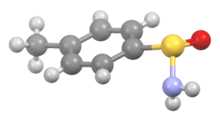Sulfinamide
 From Wikipedia the free encyclopedia
From Wikipedia the free encyclopedia

In organosulfur chemistry, sulfinamide is a functional group with the structure R−S(=O)−NR2 (where R = alkyl or aryl).[1] This functionality is composed of a sulfur-carbon (S−C) and sulfur-nitrogen (S−N) single bonds, as well as a sulfur-oxygen double bond (S=O), resulting in a tetravalent sulfur centre (in resonance with its zwitterionic form). As a non-bonding electron pair is also present on the sulfur, these compounds are also chiral. They are sometimes referred to as S-chiral sulfinamides. Sulfinamides are amides of sulfinic acid (R−S(O)OH).
Structure[edit]

Sulfinamides do not undergo inversion. They can therefore be synthesised and/or isolated in enantiopure forms. This has led to their use as chiral ammonia equivalents and more broadly as chiral auxiliaries.
Synthesis[edit]
Sulfinamides are traditionally produced by the reaction of sulfinyl chlorides with primary or secondary amines.[1] They also arise by the addition of Grignard reagents to sulfinylamines, followed by protonation:
- RMgX + R'N=S=O → RS(O)(NR'MgX)
- RS(O)(NR'MgX) + H2O → RS(O)(NR'H) + "MgX(OH)"
Yet another route entails peracid-oxidation of sulfenylphthalimides, which gives sulfinylphthalimides.
Examples[edit]
A common sulfinamide is tert-butanesulfinamide (Ellman's sulfinamide), p-toluenesulfinamide (Davis' sulfinamide), and 2,4,6-trimethylbenzenesulfinamide.[3][4][5]
Sulfinamides arise in nature by the addition of nitroxyl (HNO) to thiols:[6]
- RSH + HNO → RS(O)NH2
References[edit]
- ^ a b J. G. Tillett (1981). "Sulphinamides". In Saul Patai (ed.). Sulphinic Acids, Esters and Derivatives. PATAI'S Chemistry of Functional Groups. John Wiley & Sons. pp. 185–215. doi:10.1002/9780470772270.ch7. ISBN 978-0-471-91918-6.
- ^ Eccles, K. S.; Morrison, R. E.; Daly, C. A.; O'Mahony, G. E.; Maguire, A. R.; Lawrence, S. E. (2013). "Co-crystallisation Through Halogen Bonding with Racemic or Enantiopure Sulfinamides". CrystEngComm. 15 (37): 7571–7575. doi:10.1039/C3CE40932E.
- ^ Fanelli, D. L.; Szewczyk, J. M.; Zhang, Y.; Reddy, G. V.; Burns, D. M.; Davis, F. A. (2000). "SULFINIMINES (THIOOXIMINE S-OXIDES): ASYMMETRIC SYNTHESIS OF METHYL (R)-(+)-β-PHENYLALANATE FROM (S)-(+)-N-(BENZYLIDENE)-p-TOLUENESULFINAMIDE". Organic Syntheses. 77: 50
{{cite journal}}: CS1 maint: multiple names: authors list (link); Collected Volumes, vol. 10, p. 47. - ^ Ruano, J. L.; Alemán, J.; Parra, A.; Cid, M. B. (2007). "PREPARATION OF N-p-TOLYLSULFONYL-(E)-1-PHENYLETHYLIDENEIMINE". Organic Syntheses. 84: 129
{{cite journal}}: CS1 maint: multiple names: authors list (link). - ^ Ramachandar, T.; Wu, Y.; Zhang, J.; Franklin A. Davis (2006). "(S)-(+)-2,4,6-TRIMETHYLBENZENESULFINAMIDE". Organic Syntheses. 83: 131
{{cite journal}}: CS1 maint: multiple names: authors list (link). - ^ Keceli, Gizem; Toscano, John P. (2014-06-10). "Reactivity of C-Terminal Cysteines with HNO". Biochemistry. 53 (22): 3689–3698. doi:10.1021/bi500360x. ISSN 0006-2960. PMID 24869490.